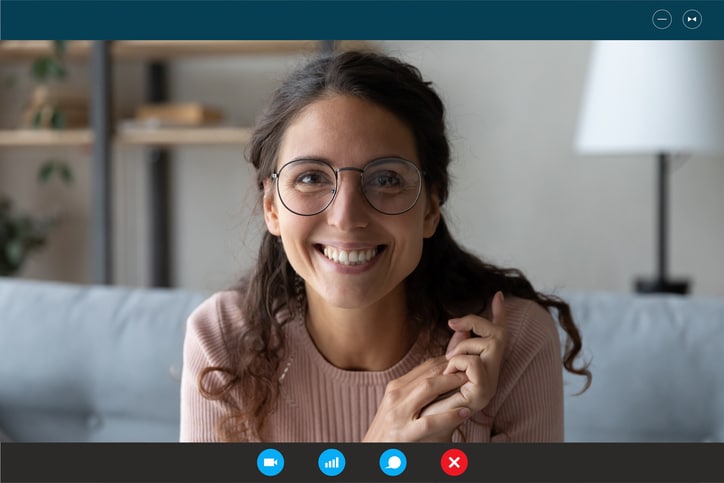What is teleconferencing?
Teleconferencing is the umbrella term for connecting two or more participants electronically. The term is mostly used to describe a telephone meeting between more than two people. Teleconferencing is a more sophisticated alternative to a two-way long-distance phone conversation (usually allowing more than two participants).
One example of a teleconference in its simplest form might be an audio conference call between two separate locations, with more than one person on either end speaking into a speakerphone.
History of teleconferencing

Historically, these teleconference meetings were conducted via traditional PBX and PSTN (public switched telephone network) telephone lines and were restricted to voice calls. However, as telecommunications technology has developed, the term is increasingly used more generically to describe the numerous ways in which we communicate in groups electronically. Some argue that there are six different teleconference types: voice communication, audio graphic, computer, video, business television (BTV), and distance education. Still, for the most part, and for the sake of simplicity, these can be condensed down to the essentials: audio conferencing and video conferencing. We will examine each in a little more detail later in this post.
In essence, a teleconference is a digital meeting between two or more participants and is mostly conducted via an audio or video call. Features available such as VoIP (voice over internet protocol) and video now offer teams an easy and effective way to communicate with each other or with clients and partners from a distance.
While landline conferencing is still available, most modern businesses will conduct teleconference meetings online or via a VoIP handset or softphone as a robust and efficient method. This post will focus primarily on the more contemporary, online-based teleconferences, which are now commonly used in our everyday business environments.
How teleconferencing works
Teleconferencing is the exchange of information between two physically distant parties. In recent years, computer telephony has developed to improve the teleconferencing experience for business users significantly.
In conference calls, business users can communicate with hundreds of listeners over their business phone system. Many businesses use these calls to deliver updates or news as a more one-way call, and others use conference calls to brainstorm and collaborate more interactively.
Participants connect to a call by dialling a designated phone number. Alternatively, an operator might call each participant individually to connect them via the conference bridge (or audio bridge). The conference bridge is a server that acts as a telephone handset to answer all phone calls simultaneously. Certain telephony systems might require callers to key in login and personal ID number to connect to the call, allowing for better confidentiality and security.

Businesses can opt to have their own bridge or choose a telephone service provider to host their conference calls. These providers often allow businesses more advanced functionality and features, including call recording, in-call operators, and attendee polling. Many VoIP telephones will allow businesses to host their own conference calls depending on the software.
In the case of web conferencing, users can communicate through video and instant messaging and just audio. That means participants can add notes, questions, or group discussion via text alongside any real-time video presentation. Most modern platforms also have features such as file sharing and screen sharing for a holistic, immersive communications session.
As with audio conferencing, businesses can choose to host their own meetings using conferencing software or opt to invest in a hosting telephony services provider. These services provide software and server space for conducting video meetings. In both cases, businesses need to ensure that they have robust, reliable software and sufficient bandwidth to support this virtual meeting.
Types of Teleconference
While there are several different methods for conducting a teleconference, we’ll stick to the two most common audio and video practices.
-
Audio Conferencing
An audio teleconference is a voice-only virtual meeting. These meetings are conducted much in the same way as a normal telephone call but can host more than two participants on one phone call. Often called a ‘conference call’, this method can interactively connect multiple caller participants, who can ‘dial in’ from across several locations via their telephone lines.
Most landline teleconferences have the capacity to host up to one hundred callers. That number is even higher for VoIP conferencing services, so audio conferencing is often used by businesses as a cost-effective and efficient way to host meetings remotely and at scale.

Another advantage of audio conferencing is that callers can dial in and participate without the need for an internet connection, meaning businesses can connect those on the move or in remote areas without experiencing significant disruption to the meeting. Those using a traditional landline telephone system would still be able to dial in and even host an audio teleconference.
That means anyone can join an audio conference using any device that supports modern telephony. Nowadays, callers can dial in from a landline, any mobile device, or a computer. Making use of this flexibility means teams can connect even when they are frequently on the move.
-
Video Conferencing
A video teleconference combines audio and video to deliver more visual calls. Video conferencing allows participants to see each other, allowing callers to experience a more immersive meeting similar to a face-to-face, in-person meeting. Due to the higher bandwidth requirements and the sophistication of the equipment, video conferencing has only become commonplace in more recent years.
Historically, these video teleconferences required IT support and a dedicated room with screens on each end for callers to meet via video conferencing technology. It is common for participants to use their mobile device to connect to a video conference call. Still, for the most part, connection via a laptop or computer is commonplace.
With video conferencing, most services have the capacity to allow over 100 participants in each session, meaning video teleconferencing is an effective way for large and small teams to meet in real-time.
Meetings can be conducted with one-way video and two-way audio, two-way video and two-way audio or a combination that suits the meeting content requirements. This flexibility allows users to deliver various teleconferences, including webinars, web conferences, interactive meetings, brainstorms, or even online training and classrooms.
Advanced features and functions of more modern telecoms technology allow the meeting host to use capabilities such as screen sharing, whiteboards, and live file sharing, meaning no-one will need a printed document on the day. These functions make video teleconferencing the ideal way to deliver a live presentation or seminar, for example, enabling speakers to share presentation slides, video clips and any other visual aids.
Different types of video teleconferencing software can enable the following examples of online conferencing benefits:
- Upload and deliver PowerPoint presentations
- Transmit live video using a webcam, or still imagery for two-way or one-way conferences, meetings, and webinars.
- Use a virtual whiteboard to make notes, brainstorm or annotate
- Annotate images and diagrams in real-time
- Host or moderator screen sharing
- Document and file sharing
- Public and private instant messaging between participants on the call
How to run an effective teleconference
Whether you choose conference calls or video calls as your teleconferencing method, there are ways to iron out glitches and make the most of the time allocated for your meeting. We’ve put together a few pointers to keep teleconference meetings on-topic, collaborative and productive.
-
Make your meeting count, and set an agenda.
Did you know, many executives spend an average of 23 hours per week in meetings. In 2019, ‘pointless’ meetings were predicted to cost US businesses $399 billion.
In a working environment where attention is increasingly limited, business leaders need to consider each meeting’s specific purpose, objectives, and desired outcomes and set an agenda to that end. Include points of discussion, attendees (so participants know that their presence is required), outline a time frame and a clear objective, distributing it to those you expect to attend. Non-attendance is common when hosting an online meeting or conference call, and without a set agenda, hosts run the risk of participants not turning up on the day.
Make it clear why you expect your invitees to attend, outlining why their attendance is needed and what they might gain from the meeting. Make your meeting content as engaging as possible; keep it brief, stick to the agenda and make it count.
-
Practice using the technology ahead of the meeting
Preparing for your meeting doesn’t necessarily mean running through your slides again. When using new and advanced technology, or even just a feature you haven’t used before, make sure you familiarise yourself with the platform to ensure you know your way around on the day of your meeting.
Be sure to access the meeting platform from an audience member perspective, so you can guide attendees through the process if they have trouble connecting to the call.
Make sure you have sufficient bandwidth for your meeting on the day. Conduct your meeting from a location where you will get the best possible connectivity to support multiple audience members. Allow a little time at the beginning of your meeting to enable users to connect, giving you a buffer for inevitable time delays and connection challenges.
-
Share key documents ahead of time.
Ideally, sharing documents ahead of the meeting with the agenda where possible can aid your meeting’s productivity. Encourage participants to read through any essential content ahead of the session to understand the meeting’s context from the outset.
This will help you reach the core objective for your meeting more efficiently, provoking more relevant discussions and questions to help other participants give insight, troubleshoot, or brainstorm effectively.
-
Be conscious of noise disruption.
It’s important to consider whether your location is appropriate for a teleconference. As well as making a note of the natural light source (for video teleconferences), it’s important to be aware of any noise disruptions that could occur, and plan accordingly for this.
It’s not a good idea to host a call from a busy café or any public space, even if their excellent WiFi connection tempts you. Think twice about using a co-working space too, as these can often be just as disruptive.
A home office with a suitable broadband internet connection is often a good choice for hosting a conference call or video call. However, If you live with others, make them aware of the call’s timings to help them avoid interrupting you accidentally. If you have a pet, try to make sure they’d be in a separate room at the time of your call and close the door if possible.
If you host calls frequently, consider investing in a headset. A good headset microphone will help you eliminate much background noise, meaning you hear your participants better and hear you more clearly.
-
Remember to record your meeting.
Gone are the days when junior team members had to write, compile, and distribute extensive meeting minutes.
With the advanced technology available to us, the chances are your teleconferencing solution will allow you to record the entirety of your meeting. That means, those that attended the meeting can review and revise any meeting content, and those that didn’t make it can catch-up at a time that suits them.
While minute taking still has its place, teleconferencing technology allows you to save time and resource by simply recording the call.
Be sure to let participants know ahead of the call if you plan to record it and remember to send the link to your invitees after the session has finished.
What Does This Mean For Your Business?
Advances in teleconferencing technology have had an undeniable impact on our day-to-day working lives.
Swiftly becoming the prevalent means of communication as businesses manage increasingly disparate team members, cloud telephony, internet telephony or unified communications solutions allow business teams, clients, and partners to connect and collaborate from wherever they are in the world.
Investing in a robust, secure, and reliable video conferencing solution is quickly becoming an essential decision for businesses looking to future-proof their business communications, benefit from cost savings, stay ahead of the curve and attract the best talent from across the globe.
Originally published Jan 06, 2021, updated Feb 15, 2022



